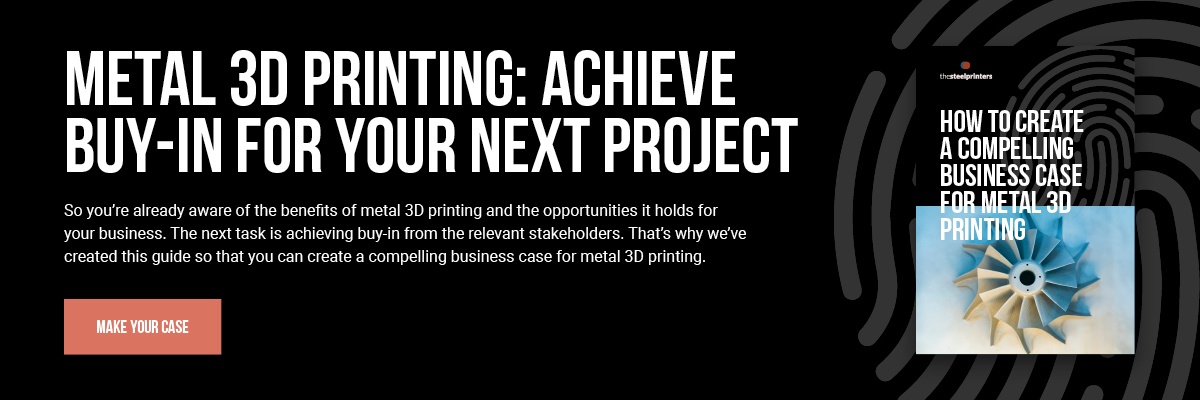Metal 3D printing presents many opportunities across multiple industries, improving productivity,...
If additive manufacturing is already on your radar and you think your company could reap the benefits, then the next logical step is to present your case and obtain that all-important stakeholder buy-in.
But creating a business case for adopting a new manufacturing technology can be a daunting task. With many elements to consider and the expectation of transforming your operations, it can be challenging to know where to start.
In this blog, we’ll cover the most important topics for building a convincing 3D printing business case, and provide you with access to our in-depth guide to help you build your own case.
- Why Build a Business Case?
- What Should You Include in Your Business Case?
- Take Your Business Case One Step Further
Why Build a Business Case?
Business cases are an essential element of any proposal aimed at transforming the way in which an organisation operates. A well-defined business case quantifies the financial opportunity and provides decision-makers with the evidence they need to move forward with a project.
First, you'll need to determine what kind of issue you are trying to solve with additive manufacturing. With a clear goal, your business case will be much more focused and results-driven, giving you more chance of receiving buy-in from key stakeholders.
Additive manufacturing holds many supply chain and production improvement opportunities, which ultimately lead to savings benefits. Building a strong business case allows you to outline the benefits to justify any changes to existing workflows and investments.
What Should You Include in Your Business Case?
Now you know why you're building a business case, you'll need to determine what to include to make your case as compelling as possible. It's essential to cover all aspects, including the challenge, solution and financial savings impact.
When thinking about the challenge, it's important to collect data and establish a baseline scenario. Data sources such as ERP systems and maintenance logs can provide valuable information about supply chain and reliability issues. Leveraging the knowledge of your shop floor team can also identify ongoing operational challenges.
Next, you’ll need to evaluate whether 3D printing is an appropriate solution to your challenge and, if so, specify the parts to 3D print. Not all parts are suited for 3D printing — many parts will need to be redesigned or optimised to realise the added value benefits of 3D printing.
As part of the business case, it’s important to outline all design changes and the impact they will have on your operations.
Arguably the most critical part is the financial savings. No matter the appeal of additive manufacturing, you're unlikely to get that all-important buy-in if the numbers don't stack up.
To do this, you’ll need to calculate the added value savings that can be achieved with additive manufacturing, including the following:
- Direct cost savings: Potential unit cost savings using metal 3D printing versus traditional manufacturing.
- Lifetime improvement savings: Part replacement savings generated by improving reliability and extending the life of a component.
- Inventory savings: The reduction in required stock levels due to faster lead times and reduced consumption.
- Operational savings: A wide range of savings types including downtime reduction, maintenance cost and defect reduction savings.
To learn more about calculating individual savings, download our business case guide.
Metal 3D printing centres around innovation, optimisation and continuous improvement. By showcasing this and the opportunities in your business case, you'll increase your chances of adopting the technology within your organisation.
Take Your Business One Step Further
Now you have a basic understanding of how to make your additive manufacturing business case, let us help you build it. Our helpful guide, How To Create a Compelling Business Case for Metal 3D Printing takes you through everything, including calculating the added value savings, identifying potential use cases, the design process and providing you with a practical example to follow.
To get started, click the link below.





